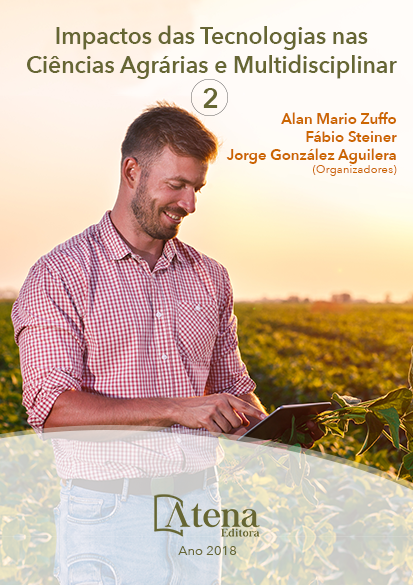
TRANSFERÊNCIA DA TECNOLOGIA INTEGRAÇÃO LAVOURA-PECUÁRIA-FLORESTA PARA PECUARISTAS NA AMAZÔNIA MARANHENSE
Com este trabalho objetivou-se
avaliar a percepção e adoção da tecnologia
integração Lavoura-Pecuária-Floresta em
quatro propriedades no município de Pindaré-
Mirim, Maranhão. O trabalho foi desenvolvido
no município de Pindaré-Mirim, utilizando
como metodologias diferentes ferramentas
de extensão como: Matriz Organizacional
ou Fortalezas, Oportunidades, Fraquezas e
Ameaças (FOFA) e Unidade de Referência
Tecnológica (URT), Dia de Campo, Visita,
Contato e Entrevista Informal, que serviram
para sensibilizar, implantar e acompanhar
os produtores rurais. Como resultados da
sensibilização foram realizados o dia de campo
que possibilitou aos pecuaristas avaliarem a
viabilidade técnica, econômica e ambiental
da tecnologia ILPF. Foram acompanhados
os pecuaristas nas atividades de preparo da
área para plantio, incorporação do calcário,
aplicação de adubo, herbicidas e inseticidas,
até a colheita de acordo com as peculiaridades
de cada propriedade. Através dos resultados
da Matriz Organizacional (FOFA) foi possível
conhecer todos os fatores que contribuíam ou
dificultavam a adoção de uma nova tecnologia
nas propriedades.
TRANSFERÊNCIA DA TECNOLOGIA INTEGRAÇÃO LAVOURA-PECUÁRIA-FLORESTA PARA PECUARISTAS NA AMAZÔNIA MARANHENSE
-
DOI: Atena
-
Palavras-chave: Agricultura de Baixo Carbono; Extensão rural; Pastagem degradada
-
Keywords: Low Carbon Agriculture; Rural extension; Degraded pasture.
-
Abstract:
The objective of this work was
to evaluate the perception and adoption of the
technology integrated of crop-livestock-forestry
in four properties in the municipality of Pindaré-
Mirim, Maranhão. The work was developed
in the municipality of Pindaré-Mirim, using
different tools such as: Organizational Matrix
or Strengths, Opportunities, Weaknesses and
Threats (SWOT) and Technological Reference
Unit (TRU), Field Day, Visit, Contact and
Informal Interview, which served to sensitize,
implement and accompany rural producers. As
a result of the sensitization, the field day was realized, which enabled cattle ranchers
to evaluate the technical, economic and environmental viability of the ICLF technology.
The ranchers were accompanied in the activities of preparation of the area for planting,
incorporation of the limestone, application of fertilizer, herbicides and insecticides, until
the harvest according to the peculiarities of each property. Through the results of the
Organizational Matrix (SWOT) it was possible to know all the factors that contributed to
or hindered the adoption of a new technology in the properties.
-
Número de páginas: 15
- Carlos Augusto Rocha de Moraes Rego


